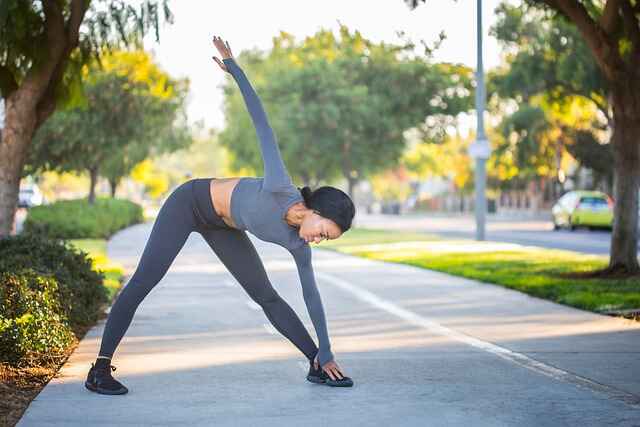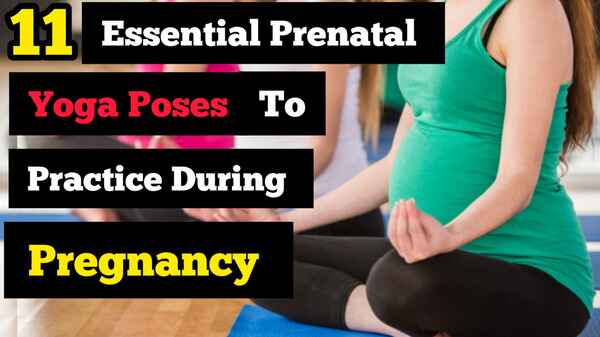Pregnancy is a transformative and special time in a woman’s life. It brings about physical and emotional changes, making it essential to take care of both body and mind. Prenatal yoga is a gentle and effective way to maintain overall well-being during pregnancy. It promotes flexibility, strength, and relaxation and prepares the body for childbirth.
Let us explore eleven essential prenatal yoga poses that are safe and beneficial for expectant mothers. Remember to consult with your healthcare provider before starting any exercise routine during pregnancy. (Source)
Also, Read What are the 10 Different Types of Pregnancy?
1. Mountain Pose (Tadasana):
Begin by standing tall with feet hip-width apart. Ground your feet and lengthen your spine. Bring your palms together in front of your heart. This pose helps improve posture, balance and strengthens the legs.
2. Cat-Cow Pose (Marjaryasana-Bitilasana):
Get down on your hands and knees, aligning your wrists under your shoulders and knees under your hips. Inhale, arch your back, lift your tailbone, and gaze upward (Cow Pose). Exhale, round your spine, tuck your tailbone, and look toward your belly (Cat Pose). This gentle flow releases tension in the spine and pelvis and improves flexibility.
3. Warrior II Pose (Virabhadrasana II):
Stand with your feet wide apart and turn your right foot out. Bend your right knee while keeping your left leg straight. Extend your arms out to the sides, parallel to the floor. Repeat on the other side. Warrior II strengthens the legs, opens the hips, and improves stamina.
4. Triangle Pose (Trikonasana):
From Warrior II, straighten your right leg and reach your right hand toward your right foot. Extend your left arm up, creating a straight line from your fingertips to your heels. Repeat on the other side. Triangle Pose stretches the sides of the body, improves balance, and relieves lower back pain.

5. Bound Angle Pose (Baddha Konasana):
Sit on the floor and bring the soles of your feet together, allowing your knees to fall open. Hold your feet or ankles with your hands. Gently press your knees toward the floor. Bound Angle Pose helps open the hips and pelvic area, relieving discomfort and preparing for childbirth.
6. Modified Side Angle Pose (Parsvakonasana):
From Warrior II, place your right hand on your right thigh and extend your left arm overhead. Repeat on the other side. This pose improves strength and stability in the legs, stretches the sides of the body, and opens the chest.
7. Child’s Pose (Balasana):
Kneel on the floor and sit back on your heels. Lower your forehead to the ground, extending your arms forward or alongside your body. Relax and breathe deeply. Child’s Pose promotes relaxation, relieves back pain, and calms the mind.
8. Seated Forward Bend (Paschimottanasana):
Sit on the floor with your legs extended in front of you. Reach forward, lengthening your spine, and gently fold forward, aiming to touch your toes or shins. This pose stretches the hamstrings, relieves tension in the lower back, and calms the nervous system.
9. Supported Bridge Pose (Setu Bandha Sarvangasana):
Lie on your back with your knees bent and feet flat on the floor. Lift your hips and place a yoga block or bolster underneath your sacrum for support. Relax your arms by your sides. The supported Bridge Pose relieves lower back pain, opens the chest, and promotes relaxation.

10. Squatting Pose (Malasana):
Stand with your feet wider than hip-width apart, toes turned out. Squat down, bringing your hips close to the floor. Place your hands together at your heart center for balance. Squatting Pose opens the hips, strengthens the legs, and helps prepare for labor and delivery.
11. Corpse Pose (Savasana):
Lie on your back, legs extended, and arms relaxed by your sides. Close your eyes and focus on deep, rhythmic breathing. Corpse Pose is a restorative posture that reduces stress, promotes relaxation, and allows for the integration of the practice.
Enjoy this precious time of connecting with your body and growing baby, and embrace the positive impact that prenatal yoga can have on your well-being. As always, consult with your healthcare provider before beginning any exercise routine during pregnancy!
Also, Read 10 Breathing Exercises For a Healthy Body & Stress-Free Mind





